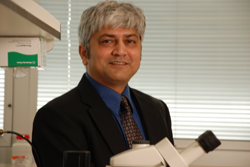 |
Iqbal Ahmad, Ph.D. |
A novel treatment for Age Related Macular Degeneration (AMD) that involves the manipulation of the Notch pathway has been discovered by a team of researchers led by UNMC’s Iqbal Ahmal, Ph.D.
Dr. Ahmad, a professor in the department of ophthalmology and visual sciences, has demonstrated in mice that alteration of this pathway profoundly affects ocular vascularization. Researchers are identifying pharmacological agents that can be injected intraocularly to successfully treat neovascularization through the Notch pathway.
The Notch signaling pathway is important for cell-to-cell communication that involves gene regulation mechanisms, which control multiple cell differentiation processes during embryonic and adult life.
This has led to identification of proteins that are found to activate stem cells. The next step is to research the efficacy and safety of using these proteins to manipulate stem cells into action and see if they regenerate and restore sight.
“This discovery could vastly improve the quality of life and independence of our aging population” said Michael Dixon, Ph.D, vice president and chief operating officer of UNeMed, the technology licensing arm of UNMC.
Dr. Ahmad has emerged as a leading researcher in the study of ocular stem cells. Following his team’s discovery of neural stem cells in adult ciliary epithelium and retina, his team also has found that corneal stem cells can serve as a potential source of neural progenitors that give rise to photoreceptors, cells that degenerate in AMD.
More than 10 million people in the United States have macular degeneration, the leading cause of severe vision loss among the elderly. And with huge numbers of baby boomers nearing retirement, low vision problems such as macular degeneration will no doubt reach a record high in the near future.
AMD comes in two forms, one of which has no cure available. The other form, neovascular AMD, is treatable. It is characterized by abnormal vascularization in the macula, ultimately causing severe vision loss.
Dr. Ahmad is in a prime position to make a major impact on America’s low vision problems. His recent research has found that adult stem cells from rat retinas may hold the key to restoring sight in those with macular degeneration and other diseases.
Dr. Ahmad believes that by using adult stem cells, doctors may be able to regenerate photoreceptors or rescue degenerating photoreceptors, which are necessary for sight but are destroyed in macular degeneration.
“Once you have macular degeneration, your ability to recognize faces, read and drive is progressively compromised,” Dr. Ahmad said. “Our goal is to use stem cells to discover new drugs and genes that will help slow down the degenerative process. If we can find a way to give people another 10 years of better vision, that would be a great improvement.”
Dr. Ahmad’s research team has observed that one particular type of adult stem cell in the eyes — known as Muller cells — are found throughout the adult retina. Muller cells are able to self-renew and have the potential to generate retinal neurons.
“For some reason, these cells lay dormant and only become active when the retina is injured,” he said. “The problem is, right now we don’t know how specific injury activates Muller cells.”
By inducing injury in the retina of lab rats, Dr. Ahmad said some of the activated Muller cells have become new photoreceptors, which is critical to a person’s vision.
|
|
“It is known that two millimeters of tissue surrounding the cornea, where stem cells are located, can be removed without impacting eyesight,” he said. “The cornea, brain and retina have the same embryonic origin.”
Dr. Ahmad’s research team recently published its findings in the journal Stem Cells, and has shared the findings at a number of national scientific conferences. Their findings demonstrated that corneal stem cells could be converted into photoreceptors, he said, which suggests that they also could be used for repairing retinal damage.
“This gives us hope that we may be able to manipulate these cells to treat retinal degeneration and restore sight,” he said. “By using a person’s own Muller adult stem cells, problems associated with immune rejection as well as the controversy surrounding the use of embryonic stem cells would be eliminated.”
In the coming years, Dr. Ahmad hopes to move his research from animals to human clinical trials. Although a cure could take several years, he is optimistic that a breakthrough in treatment of age-related macular degeneration is likely through multi-prong stem cell approaches.
UNeMed offers licensing options and collaborative development opportunities with UNMC.